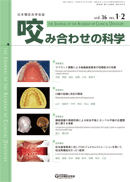Volume 36, Issue 1-2
Displaying 1-15 of 15 articles from this issue
- |<
- <
- 1
- >
- >|
REVIEW
-
2016Volume 36Issue 1-2 Pages 11-
Published: April 25, 2016
Released on J-STAGE: July 30, 2019
Download PDF (1282K)
-
2016Volume 36Issue 1-2 Pages 17-
Published: April 25, 2016
Released on J-STAGE: July 30, 2019
Download PDF (1134K) -
2016Volume 36Issue 1-2 Pages 25-
Published: April 25, 2016
Released on J-STAGE: July 30, 2019
Download PDF (1598K) -
2016Volume 36Issue 1-2 Pages 33-
Published: April 25, 2016
Released on J-STAGE: July 30, 2019
Download PDF (804K)
-
Article type: case-report
2016Volume 36Issue 1-2 Pages 42-
Published: April 25, 2016
Released on J-STAGE: July 30, 2019
Download PDF (1429K) -
2016Volume 36Issue 1-2 Pages 51-
Published: April 25, 2016
Released on J-STAGE: July 30, 2019
Download PDF (1271K) -
Article type: case-report
2016Volume 36Issue 1-2 Pages 59-
Published: April 25, 2016
Released on J-STAGE: July 30, 2019
Download PDF (1368K) -
A case of occlusal reconstruction for bite collapse patient by utilizing the provisional restoration2016Volume 36Issue 1-2 Pages 65-
Published: April 25, 2016
Released on J-STAGE: July 30, 2019
Download PDF (1289K) -
2016Volume 36Issue 1-2 Pages 71-
Published: April 25, 2016
Released on J-STAGE: July 30, 2019
Download PDF (2430K) -
Article type: case-report
2016Volume 36Issue 1-2 Pages 80-
Published: April 25, 2016
Released on J-STAGE: July 30, 2019
Download PDF (694K)
-
2016Volume 36Issue 1-2 Pages 83-
Published: April 25, 2016
Released on J-STAGE: July 30, 2019
Download PDF (1119K) -
2016Volume 36Issue 1-2 Pages 87-
Published: April 25, 2016
Released on J-STAGE: July 30, 2019
Download PDF (887K) -
2016Volume 36Issue 1-2 Pages 91-
Published: April 25, 2016
Released on J-STAGE: July 30, 2019
Download PDF (792K) -
2016Volume 36Issue 1-2 Pages 97-
Published: April 25, 2016
Released on J-STAGE: July 30, 2019
Download PDF (1346K) -
Article type: oration
2016Volume 36Issue 1-2 Pages 104-
Published: April 25, 2016
Released on J-STAGE: July 30, 2019
Download PDF (1208K)
- |<
- <
- 1
- >
- >|
